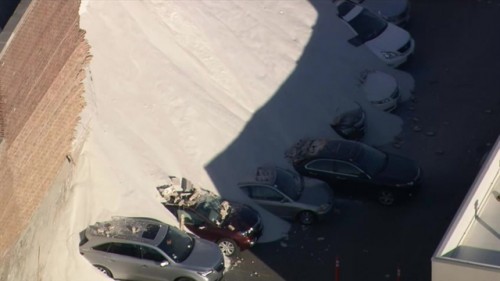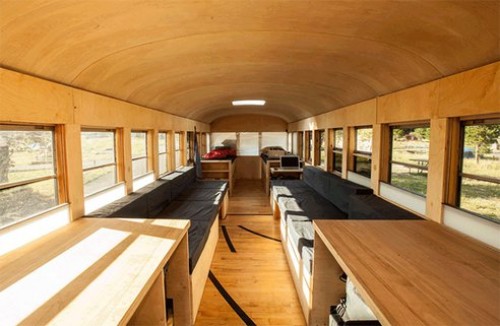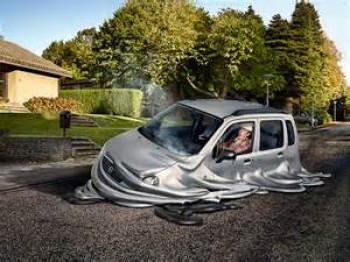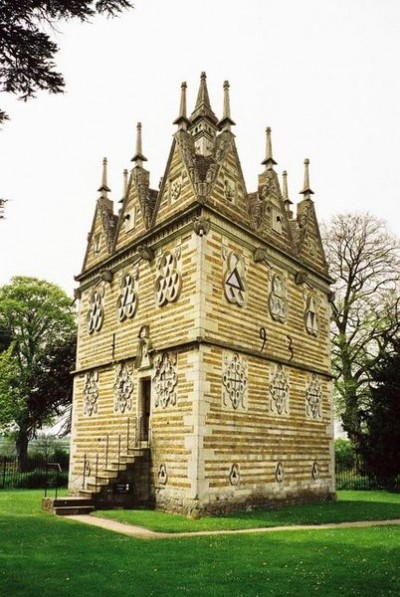Architecture
Road Salt Bad For Cars

Bet Mortons is feeling pretty salty now!
Posted By: Alex - Wed Dec 31, 2014 -
Comments (7)
Category: Accidents, Architecture
Upside-Down House
British artist Alex Chinneck does strange things with buildings. His latest project involved flipping a London building upside-down so that the front door is now at the top. (He didn't actually turn it upside-down. He attached a brick veneer to the outside to make it look that way.)
In an earlier project, a building's brick veneer appears to be sliding off the house.

Posted By: Alex - Sat Jan 18, 2014 -
Comments (9)
Category: Architecture, Art
The Real Geo

(Flickr source.)
A reader known as "Pat@[email protected]" recently wrote in with some good info on an old WU topic:
" I have been a fan of Buckminster Fuller's writings for many years and just recently found out that he actually didn't invent the geodesic dome. It was invented by Walther Bauersfeld, a German engineer, some 30 years earlier for use as the first projection planetarium. Fuller did, however, apply for and was granted the U.S. patents. He took it's design and construction further and is credited with popularizing it. We have one in Fairbanks built in 1966 at a site originally called "Alaskaland" which was built to commemorate the centenial of the purchase of Alaska from Russia in 1867. It's called the Gold Dome and now houses an aviation museum. Also, there were many "golf balls" in the state during the Cold War which were used for radar."
Posted By: Paul - Tue Oct 29, 2013 -
Comments (5)
Category: Architecture, Inventions, 1920s
Busmobile

A architectural student at University of Minnesota decided on a rather interesting thesis project. Hank Butitta transformed an old school bus into a cool mobile home. Its the Busmobile!
Posted By: Alex - Wed Sep 25, 2013 -
Comments (6)
Category: Architecture
Didn’t Think It Through

If you're going to build a multi million dollar (or Euro) skyscraper you might want to be sure the glass in it will not reflect sunlight strongly enough to melt cars on the street.
Posted By: Alex - Tue Sep 03, 2013 -
Comments (6)
Category: Architecture
World’s Thinnest House
What's less than four feet wide, thirty-feet tall and thirty-three feet deep? And has a ladder entrance ten feet off the ground?
This 3D visualization gives you an idea what can be done when an old building and a newer building leave four feet between them. It's meant as a statement about the war destruction in Poland and the rebuilding being connected. The Keret home is named for the writer who will be living there.
He moves in Saturday, and says the narrow house is a "a kind of a memorial to my family," says Etgar Keret, whose mother's and father's families died in the Holocaust. His paternal grandfather died in Warsaw's uprising against the Nazis in 1944.
Here's the link for the whole story and more pictures.
http://www.huffingtonpost.com/2012/10/19/narrow-house-opening-as-a_0_n_1987050.html?utm_hp_ref=weird-news&ir=Weird%20News
Toilet and shower included, plus an "almost" double bed.
Not living large -- living thin!!
Posted By: gdanea - Mon Oct 22, 2012 -
Comments (10)
Category: Architecture
Jack Fletcher’s House of the Future
In 1954, 23-year-old Jack Fletcher showed off his new home to the media. Reporters called it the "house of the future" because of all the unique features he had designed into it. The windows closed by themselves when sensors felt rain. Lights came on automatically when someone entered a room. The phone had a speed-dial feature. The lamps didn't need cords. Instead you just placed them over induction coils installed in the floor. And strangest of all, electromagnets caused pots and pans to float over the stove (which also used induction coils to heat the food).The house was in West Covina, CA (in the LA area). I wonder if it's still standing? I don't see why it wouldn't be, but I haven't been able to find an address for it. Read more about it here and here.




Posted By: Alex - Fri Jul 06, 2012 -
Comments (9)
Category: Architecture, Buildings and Other Structures, Futurism
Why do evil people live in modernist homes?

The book blurb:
Posted By: Alex - Fri Jan 20, 2012 -
Comments (3)
Category: Architecture, Movies
House of the Future
Here's your weekend viewing!
Posted By: Paul - Fri Jan 28, 2011 -
Comments (2)
Category: Architecture, 1950s, Yesterday’s Tomorrows
The Triangular Lodge

No, it's not the Vatican!
Posted By: Paul - Wed Jan 26, 2011 -
Comments (5)
Category: Architecture, Eccentrics, Religion, Sixteenth Century

| Who We Are |
|---|
| Alex Boese Alex is the creator and curator of the Museum of Hoaxes. He's also the author of various weird, non-fiction, science-themed books such as Elephants on Acid and Psychedelic Apes. Paul Di Filippo Paul has been paid to put weird ideas into fictional form for over thirty years, in his career as a noted science fiction writer. He has recently begun blogging on many curious topics with three fellow writers at The Inferior 4+1. Contact Us |




